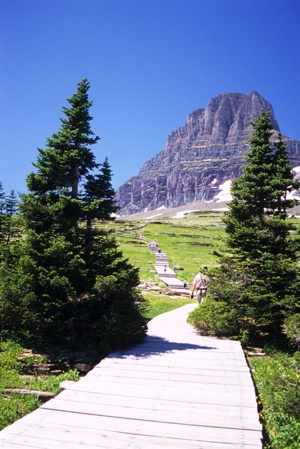Often described as a hiker's paradise, Glacier has more than 700 miles of trails, ranging from challenging backcountry treks to wheelchair accessible, self-guiding walks.
The short hikes at Hidden Lake, Sun Point, and the Trail of the Cedars will give you a good sample of the dramatically different ecosystems found in the park. For veteran backpackers, Glacier's backcountry offers a raw, rugged landscape roamed by wolves, grizzly bears, and wolverines.
Trail Status Summary
The following generalization is provided for your convenience to better understand what you may encounter when backpacking in Glacier.
May 1 – June 30 Early Season
Trails are often muddy and covered in puddles or flowing water at lower elevations. Water crossings are deep, swift, and cold. Seasonal suspension and plank bridges start to be installed in late May. Expect snow cover at higher elevations and be prepared with map and compass skills for route finding, and ice axe and crampons for crossing steep slopes. Snow conditions can change daily: icy in the morning, soft in the afternoon. Backcountry Campgrounds earliest scheduled openings begin June 15th, but the Belly River region in the northeast and the North Fork region in the northwest are often accessible in May.July 1 – July 31 Transition into Summer
Trails dry out and firm up at lower elevations. Melting snow presents dynamic hazards at higher elevations, ice axe often recommended. Seasonal suspension and plank bridges are all installed by mid-July. Ptarmigan Tunnel doors open in mid-July. Snow drift blasting and treading is completed by Trail Crew by the end of July. The majority of the backcountry campgrounds are open by mid-July although the routes connecting the campgrounds may still be impassible.August 1 – Aug 31 Accessible High Country
Generally, snow and water hazards are gone although water hazards may suddenly re-appear after thunderstorms. Backcountry Campgrounds are open but may close at any time due to bear activity or forest fire for days or weeks.September 1 – November 20 Autumn
Some Septembers are as nice as August, but there is a now a greater chance of significant snow fall. Snow storms may deposit lingering snow, requiring map and compass skills for route finding. Snow hazards may begin to develop. Bears are most active at this time of year, foraging for up to 20 hours a day. Seasonal suspension and plank bridges are all removed by late September. Ptarmigan Tunnel doors close by late September.November 20 – April 31 Winter
Campgrounds go into winter status.
Hikes Featured in the Traveler

The hike to Hidden Lake starts out with a nice boardwalk stroll.
Kurt Repanshek photo
* Just getting out of your rig in the parking lot atop Logan Pass in Glacier National Park offers spectacular views, but with a little effort and perhaps two hours of time you'll be searching for a word to amplify "spectacular." The 1.5-mile hike to the Hidden Lake overlook starts out behind the Logan Pass Visitor Center and follows a boardwalk and dirt trail through meadows that in summer are awash both with wildflowers, rivulets of snowmelt, and wildlife.
You can find the rest of this story on this page.
Hiking Trails In the Park
Park officials break down their trails by section across the park. Here's a listing of those sections, which are embedded with hotlinks to trail maps created by the park staff.
To get the latest update on trail conditions, check this site maintained by the park.


